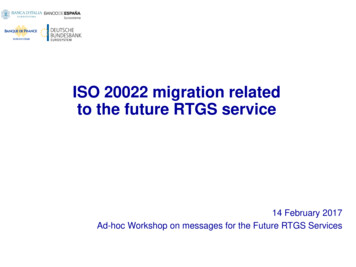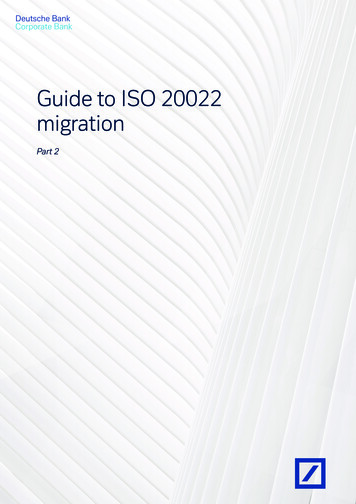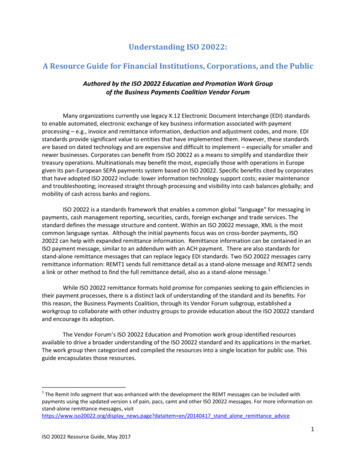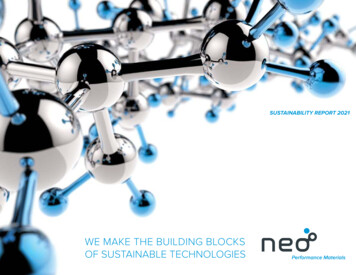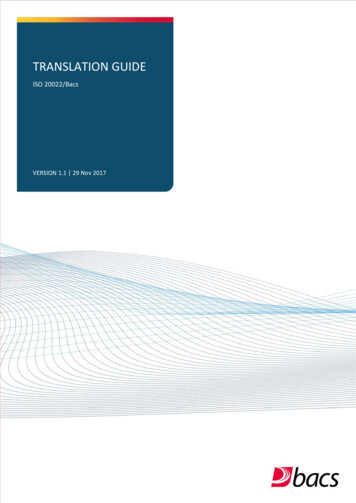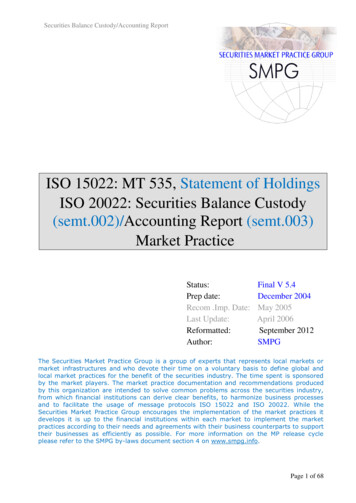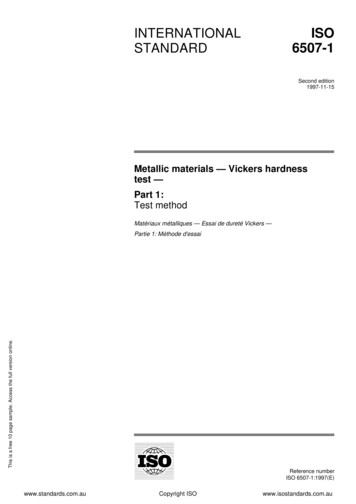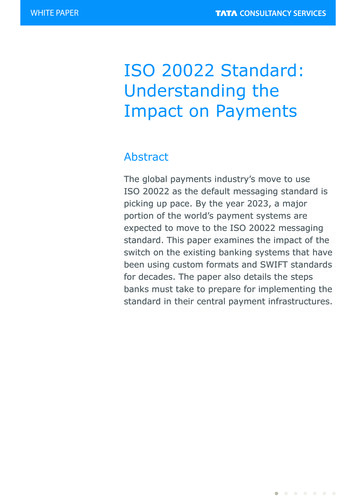
Transcription
WHITE PAPERISO 20022 Standard:Understanding theImpact on PaymentsAbstractThe global payments industry’s move to useISO 20022 as the default messaging standard ispicking up pace. By the year 2023, a majorportion of the world’s payment systems areexpected to move to the ISO 20022 messagingstandard. This paper examines the impact of theswitch on the existing banking systems that havebeen using custom formats and SWIFT standardsfor decades. The paper also details the stepsbanks must take to prepare for implementing thestandard in their central payment infrastructures.
WHITE PAPERISO 20022: Impact on UK FinancialServicesThe Bank of England (BoE) plans to renew the existing realtime gross settlement (RTGS) system; in parallel, Pay.UK hasbegun the journey of creating the New Payments Architecture(NPA), a single core clearing and settlement platform. With thecommon vision of bringing harmonised and more alignedtransactions in the UK payment system, BoE and Pay.UK havecollaboratively decided to adopt a new message type, CommonUK Credit Message (CCM), using the ISO 20022 standard forthe transmission of the transaction message. CCMimplementation will deliver myriad bene ts to the UK paymentsystems: fully aligned message structure across paymentschemes, a uni ed payments ecosystem, operational resilience,domestic interoperability, international harmonisation (for crossborder transactions), and greater support for overlay services.CCM ImplementationThe BoE has mandated ISO 20022 implementation in fourphases (see Table 1).Phase NameDescriptionDeadlineEnd 2019 for introductoryEnd 2020 for enhanced1PreparationphaseBaselining and publishing the final messages to be included in RTGSand NPA2IntroductoryphaseAdoption of ISO 20022 messages equivalent to current message types Early 20223EnhancementphaseIntroduction of the new data fieldsEarly 20234Mature phaseFurther enhancements to data requirements for CCM and regularmaintenance2024 and beyondTable 1: ISO 20022 Implementation TimeframeFor the enhancement phase, the BoE has mandated four keyenhancements:nIdentity structured address elds and legal entity identi ernPayment purpose codenStructured remittance informationnExtended character set supportThe BoE consultation leveraged the guidelines created by theSWIFT HVPS task force for the international harmonisation.The proposed CCM standard was customised to UK transactionswhile also meeting the needs of the individual schemes. Thishas resulted in a common block of the core message structurewith scheme-speci c attributes, while ensuring that the overall
WHITE PAPERCCM message structure is a subset of the HVPS guidelines tomaintain global interoperability (see Figure 1).HVPS GuidelinesCommon UK Credit MessageCHAPS Scheme RulesOverlap of CCM implementationBacs & Faster Payments Schemes RulesFigure 1: ISO 20022 CommonalitiesThe BoE is planning an incremental release of capability for theISO 20022 standard with the rst release expected by early2022. Pay.UK is also planning the implementation of the CCMstandard on the other UK domestic schemes in a slightly longertimeframe starting with the replacement of the FasterPayments scheme.Additional ISO20022 Message FormatsThe CCM is just the start of the ISO 20022 journey. The ISO20022 standard has a large set of relevant formats that willbring further consistency to communication with banks andbetween banks. These will cover debit, credit, mandates,settlement, investigations and statements to name the keyones. Table 2 depicts the formats that are expected to beintroduced, and will replace the current custom formats. Forexample, banks custom corporate host-to-host messages,unsolicited messages (USMs), SWIFT MT messages forsettlement, custom investigation processes between banks,and paperless direct debit messages will be replaced.End customerInterbank , Pain.002,Pain.007, Pain.008Pain.009, Pain.010,Pain.011, Pain.012Pacs.002, Pacs.007,Pacs.008, Pacs.004Pacs.009, Pacs.010,Pacs.002Overlay servicesPayment uest to Pay:Pain.013, Pain.014Enhanced Data:Remt.001, Remt.002Camt.052, Camt.053,Camt.054Camt.052, Camt.056,Admi.0nnCamt.029, Camt.030Table 2: ISO20022 Message Types
WHITE PAPERImpact on BanksAdopting ISO 20022 will mandate changes to banks’ systemsand processes; proactive preparation will make for a hasslefree and smooth migration. Adopting a structured agileapproach will enable incremental delivery of change to complywith the regulation as well as the ability to adapt to evolvingregulations and new products. The impacts can be categorizedinto some key areas:Payments engine: Core to ISO 20022 adoption is thebackend payments engine that consumes and produces themessage format and enables end-to-end processing andcommunication with other enterprise services. Enabling thepayments engine to use the ISO 20022 format as the canonicalmodel is not essential to success; however, many paymentproducts and banks are adopting this approach given its richstructure and the thought that has gone into developing thestandard. At a minimum, use of the ISO20022 data types willsimplify format translations.The other fundamental change will revolve arounddecommissioning or amalgamating multiple engines that arecurrently aligned to the existing payment schemes, into asingle, high-performing engine that ensures high availability. Inthe absence of a clearly de ned separation of the engine fromthe remaining estate, this is likely to have a ripple effect acrossthe bank.Migration to ISO 20022: Smooth migration ensures minimalimpact to the banks’ customers. Some key aspects that banksmust consider while de ning the migration strategy include:nCost of maintaining both the legacy and the new ISO 20022compatible systemsnOperational impacts due to the data truncation and new data eldsnData translation and data cleansing to transition to the ISO20022 format, especially if moving from free text to stronglytyped eldsnSeamless migration from existing schemes to the NPA andnew RTGSnInterim format translators to maintain backward compatibilityCareful planning will be required and we recommend thatbanks run pilots with a robust regression test suite covering allthe customer types.End-to-end ISO 20022 adoption: To fully utilise the bene tsof the richer data structures of ISO 20022 and ensureconsistency, the way banks interact with consumer andcorporate entities will need to change. Additional mandatory
WHITE PAPERdata will need to be captured from the users by enhancing thebanking channels to adopt the pain.001 format and thecustomer experience will need to be reviewed across four areas– retail channels, corporate channels, bank staff channels, andbank internal originators that generate direct debit les.Data storage and management: The ISO 20022 messageformat allows for richer data capabilities; however, managingand storing the additional transaction data poses challenges.Banks will need to update the existing database or upgrade toa completely new database. In addition, banks will facechallenges in retaining and storing old data for regulatorycompliance. The change to the format will also lead todownstream impacts; for example, complexities in reportingand analytics and additional storage costs.Operational processes: Banks will need to updateoperational processes to handle transactions with insuf cientdata and data truncation issues post migration, in addition toeducating customers on the new data points to be captured.Next StepsBanks have to complete development and testing and migrateto ISO 20022 by 2022. This can be achieved by managing thetranslation from legacy formats to ISO 20022 at the messagegateway. However, reaping the complete bene ts of the ISO20022 format will require the enhanced data and new datapoints to percolate into the channels as well as the consumersand organizations that initiate the payment. This will requirechanges to how customers initiate payments, the introductionof innovative products and services to provide moreinformation to consumers, and simpli cation of paymentschemes to name a few.To ensure a seamless migration to ISO 20022, banks must:nPerform end-to-end impact assessment and gap analysis ofpayment data from capture to execution and archive. Identifyall the impacted channels and touch points including allchannels that can originate payments.nReview the data format and in and out interfaces for eachtouchpoint in the payment value chain to identify readinessfor migration to the ISO 20022 standard and the ability tohandle new data points and extended elds.nMap the gap analysis to the enterprise strategy to identifyimpacted systems and processes. Align change programswith the enterprise strategy for the payment engine.nDraw up a roadmap to implement incremental changes to theestate; focus on decoupling systems into standardintegrations and minimising customer impact.
WHITE PAPERnEnsure effective customer communication, especially forcorporate customers using custom host-to-host formats,which will be crucial to a successful move to ISO 20022.Look Beyond ComplianceBanks must not view ISO 20022 migration merely as acompliance exercise but think beyond the immediate regulatorymandate and look at unlocking value by leveraging the bene tsof ISO 20022. This could include creating new products thatutilise the extended remittance data, enhancing the APIintegration with corporate ERP solutions, and using theadditional rich data to build new analytical models as well ascraft offers personalised to individual customers. In addition togreater interoperability, richer data, more ef cient processes,and better compliance, ISO 20022 offers an opportunity forbanks to re-examine business models, improve customerservice, and strengthen market positioning thereby generatingexponential value.
WHITE PAPERAbout The AuthorRakesh LakhaniRakesh leads the PaymentTransformation practice of TCS'Banking, Financial Services andInsurance (BFSI) unit. He hasover two decades of experience indomestic and cross-borderfinancial systems. Rakesh playsan active role in managingconsulting and deliveryengagements covering thoughtleadership, innovation, analysis,solution definition and design, andplanning and implementation.ContactVisit the Banking & Financial Services page on www.tcs.comEmail: bfs.marketing@tcs.comBlog: Bank of the FutureSubscribe to TCS White PapersTCS.com RSS: http://www.tcs.com/rss feeds/Pages/feed.aspx?f wFeedburner: http://feeds2.feedburner.com/tcswhitepapersTata Consultancy Services is an IT services, consulting and business solutionsorganization that delivers real results to global business, ensuring a level ofcertainty no other firm can match. TCS offers a consulting-led, integrated portfolioof IT and IT-enabled, infrastructure, engineering and assurance services. This isdelivered through its unique Global Network Delivery ModelTM, recognized as thebenchmark of excellence in software development. A part of the Tata Group,India’s largest industrial conglomerate, TCS has a global footprint and is listed onthe National Stock Exchange and Bombay Stock Exchange in India.For more information, visit us at www.tcs.comAll content / information present here is the exclusive property of Tata Consultancy Services Limited (TCS). The content / information contained here iscorrect at the time of publishing. No material from here may be copied, modified, reproduced, republished, uploaded, transmitted, posted or distributedin any form without prior written permission from TCS. Unauthorized use of the content / information appearing here may violate copyright, trademarkand other applicable laws, and could result in criminal or civil penalties. Copyright 2019 Tata Consultancy Services LimitedTCS Design Services I M I 12 I 19About Tata Consultancy Services Ltd (TCS)
Payments engine: Core to ISO 20022 adoption is the backend payments engine that consumes and produces the message format and enables end-to-end processing and communication with other enterprise services. Enabling the payments engine to use the ISO 20022 format as the canonical model is not essential to success; however, many payment

